Griffith University: Future Automation Workforce Analysis
VerifiedAdded on 2023/01/17
|16
|2948
|42
Report
AI Summary
This report delves into the critical topic of preparing the workforce for the future of automation. It begins by outlining the transformative impact of automation and artificial intelligence (AI) on businesses, economies, and societies, highlighting the opportunities and challenges that arise. The report explores the effects of AI and automation on work, including workforce transitions and potential job displacement, while also acknowledging the simultaneous creation of new job roles. It emphasizes the importance of reskilling and upskilling the workforce to adapt to these changes, especially in emerging and developing economies. The report discusses the challenges and strategies for workforce transition, including the need for advanced digital and technological skills and the shift in skill demands. It analyzes the impact of automation on emerging and developing economies, such as India and China, highlighting the need for vocational training, foreign direct investment, and effective handling of potential unemployment. Furthermore, it examines the readiness of the current and future workforce to embrace technological advancements and the importance of government support. The report concludes by emphasizing the need for nations to support their workforce in adapting to the digital environment, showcasing the ongoing transformation in the way we work and earn a living.
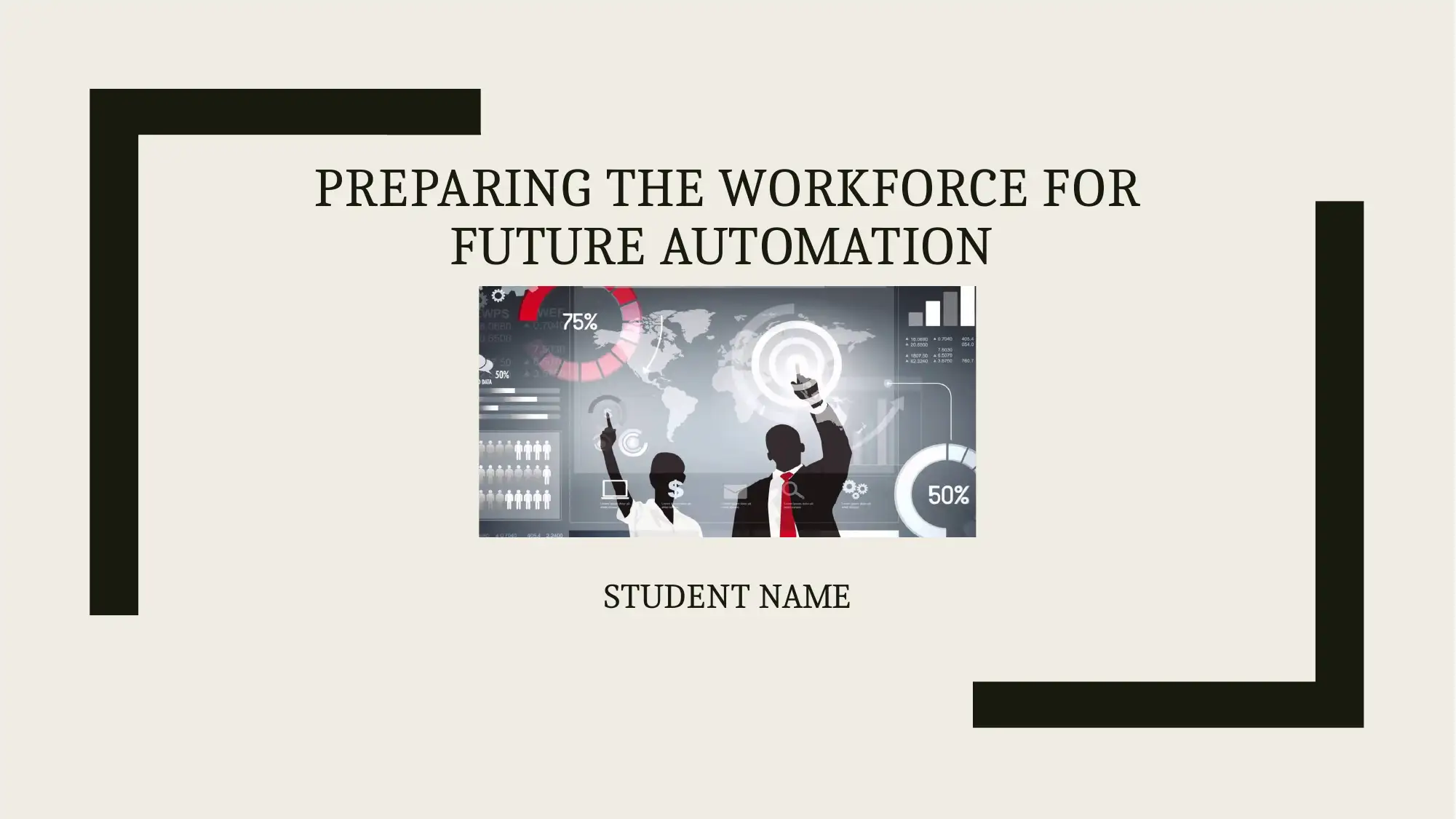
PREPARING THE WORKFORCE FOR
FUTURE AUTOMATION
STUDENT NAME
FUTURE AUTOMATION
STUDENT NAME
Paraphrase This Document
Need a fresh take? Get an instant paraphrase of this document with our AI Paraphraser
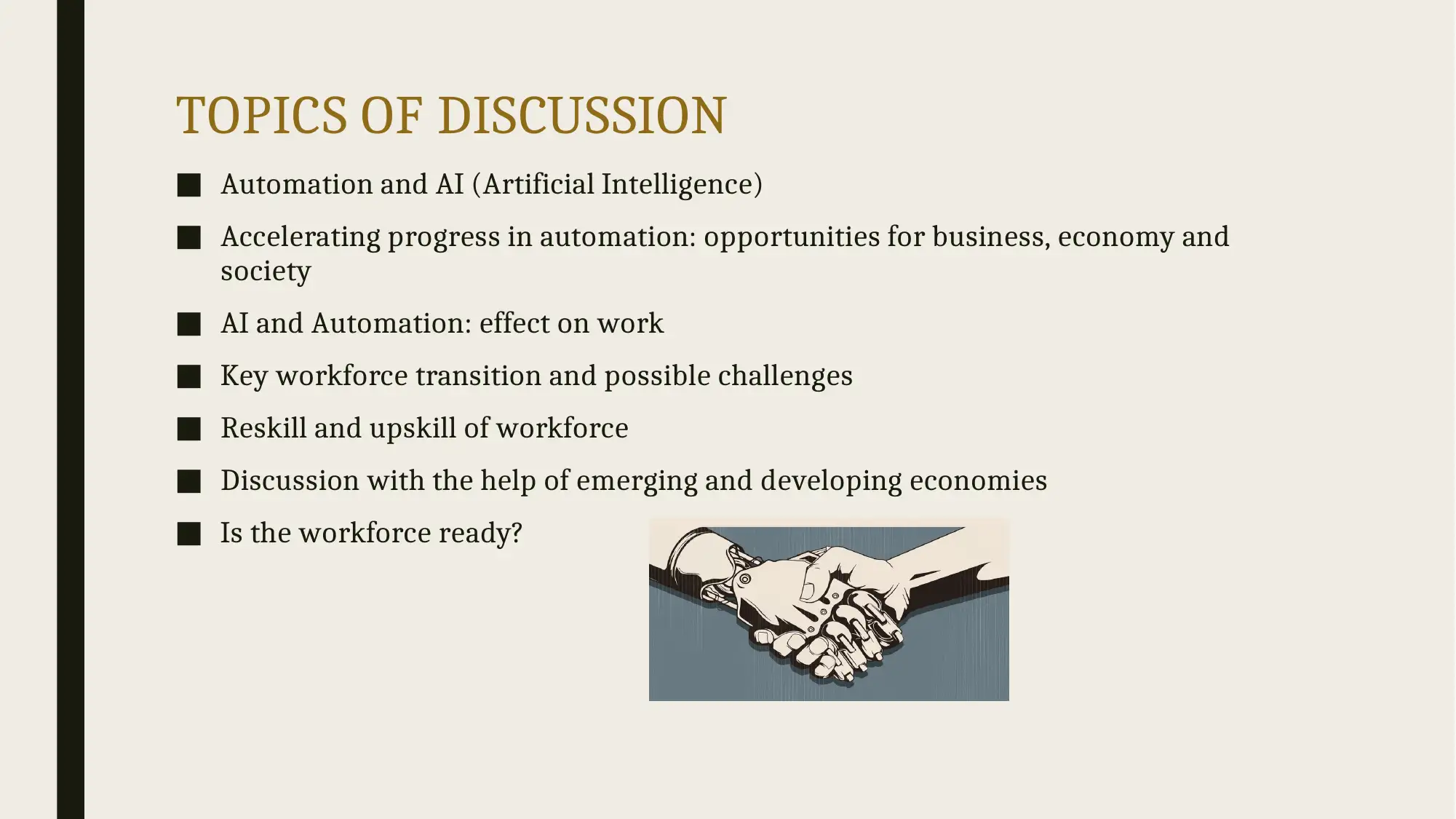
TOPICS OF DISCUSSION
■ Automation and AI (Artificial Intelligence)
■ Accelerating progress in automation: opportunities for business, economy and
society
■ AI and Automation: effect on work
■ Key workforce transition and possible challenges
■ Reskill and upskill of workforce
■ Discussion with the help of emerging and developing economies
■ Is the workforce ready?
■ Automation and AI (Artificial Intelligence)
■ Accelerating progress in automation: opportunities for business, economy and
society
■ AI and Automation: effect on work
■ Key workforce transition and possible challenges
■ Reskill and upskill of workforce
■ Discussion with the help of emerging and developing economies
■ Is the workforce ready?
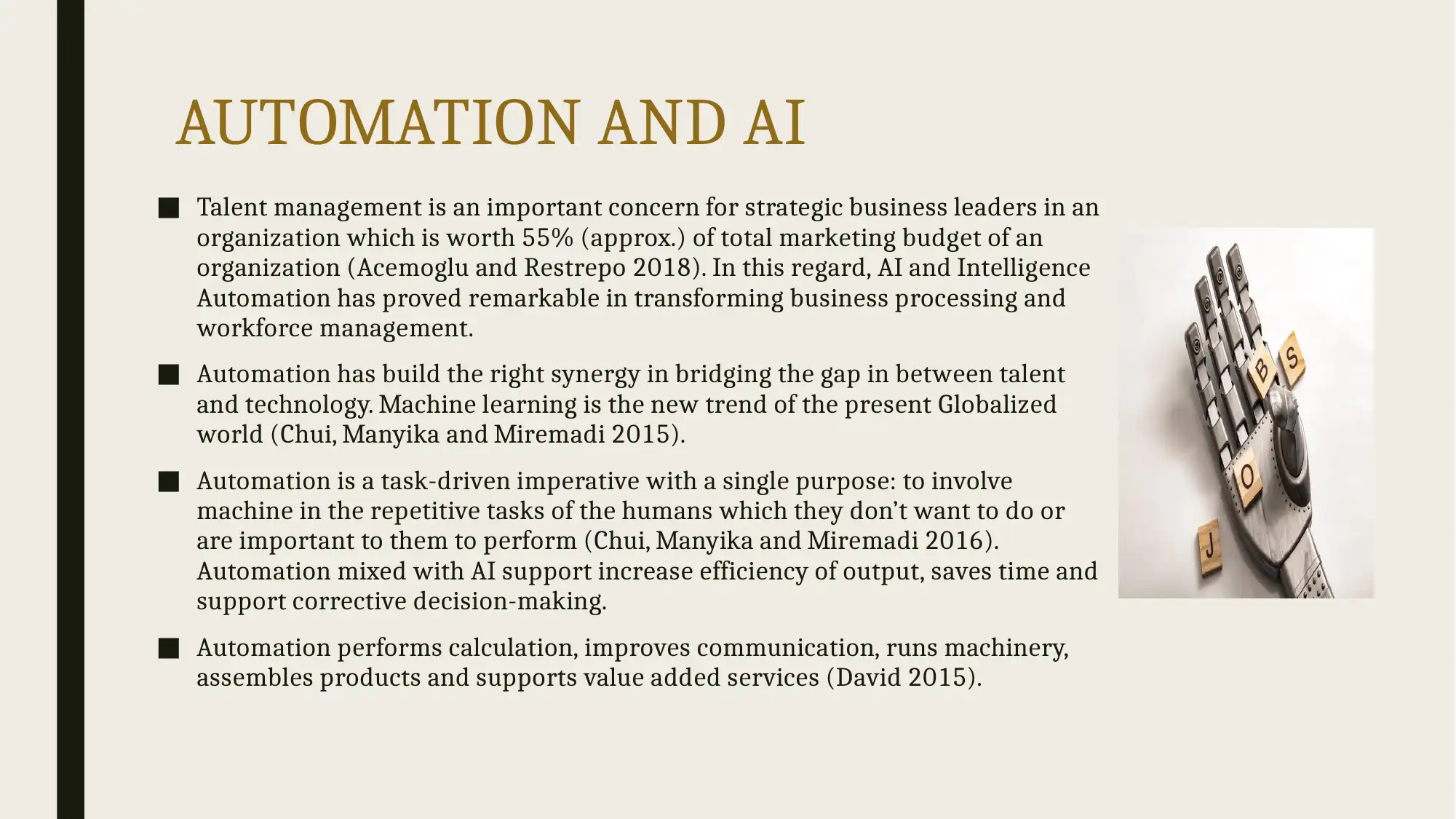
AUTOMATION AND AI
■ Talent management is an important concern for strategic business leaders in an
organization which is worth 55% (approx.) of total marketing budget of an
organization (Acemoglu and Restrepo 2018). In this regard, AI and Intelligence
Automation has proved remarkable in transforming business processing and
workforce management.
■ Automation has build the right synergy in bridging the gap in between talent
and technology. Machine learning is the new trend of the present Globalized
world (Chui, Manyika and Miremadi 2015).
■ Automation is a task-driven imperative with a single purpose: to involve
machine in the repetitive tasks of the humans which they don’t want to do or
are important to them to perform (Chui, Manyika and Miremadi 2016).
Automation mixed with AI support increase efficiency of output, saves time and
support corrective decision-making.
■ Automation performs calculation, improves communication, runs machinery,
assembles products and supports value added services (David 2015).
■ Talent management is an important concern for strategic business leaders in an
organization which is worth 55% (approx.) of total marketing budget of an
organization (Acemoglu and Restrepo 2018). In this regard, AI and Intelligence
Automation has proved remarkable in transforming business processing and
workforce management.
■ Automation has build the right synergy in bridging the gap in between talent
and technology. Machine learning is the new trend of the present Globalized
world (Chui, Manyika and Miremadi 2015).
■ Automation is a task-driven imperative with a single purpose: to involve
machine in the repetitive tasks of the humans which they don’t want to do or
are important to them to perform (Chui, Manyika and Miremadi 2016).
Automation mixed with AI support increase efficiency of output, saves time and
support corrective decision-making.
■ Automation performs calculation, improves communication, runs machinery,
assembles products and supports value added services (David 2015).
⊘ This is a preview!⊘
Do you want full access?
Subscribe today to unlock all pages.

Trusted by 1+ million students worldwide
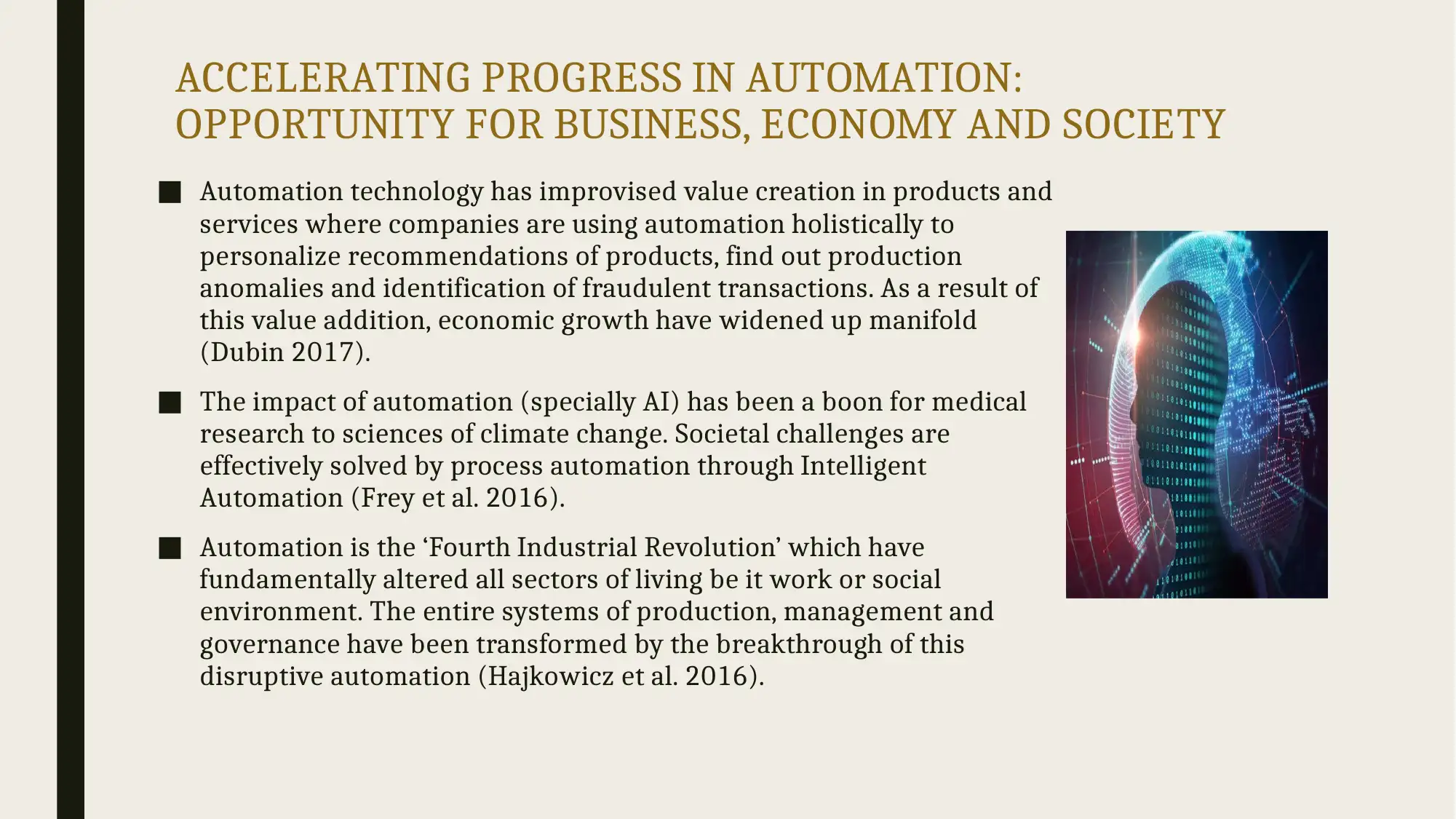
ACCELERATING PROGRESS IN AUTOMATION:
OPPORTUNITY FOR BUSINESS, ECONOMY AND SOCIETY
■ Automation technology has improvised value creation in products and
services where companies are using automation holistically to
personalize recommendations of products, find out production
anomalies and identification of fraudulent transactions. As a result of
this value addition, economic growth have widened up manifold
(Dubin 2017).
■ The impact of automation (specially AI) has been a boon for medical
research to sciences of climate change. Societal challenges are
effectively solved by process automation through Intelligent
Automation (Frey et al. 2016).
■ Automation is the ‘Fourth Industrial Revolution’ which have
fundamentally altered all sectors of living be it work or social
environment. The entire systems of production, management and
governance have been transformed by the breakthrough of this
disruptive automation (Hajkowicz et al. 2016).
OPPORTUNITY FOR BUSINESS, ECONOMY AND SOCIETY
■ Automation technology has improvised value creation in products and
services where companies are using automation holistically to
personalize recommendations of products, find out production
anomalies and identification of fraudulent transactions. As a result of
this value addition, economic growth have widened up manifold
(Dubin 2017).
■ The impact of automation (specially AI) has been a boon for medical
research to sciences of climate change. Societal challenges are
effectively solved by process automation through Intelligent
Automation (Frey et al. 2016).
■ Automation is the ‘Fourth Industrial Revolution’ which have
fundamentally altered all sectors of living be it work or social
environment. The entire systems of production, management and
governance have been transformed by the breakthrough of this
disruptive automation (Hajkowicz et al. 2016).
Paraphrase This Document
Need a fresh take? Get an instant paraphrase of this document with our AI Paraphraser
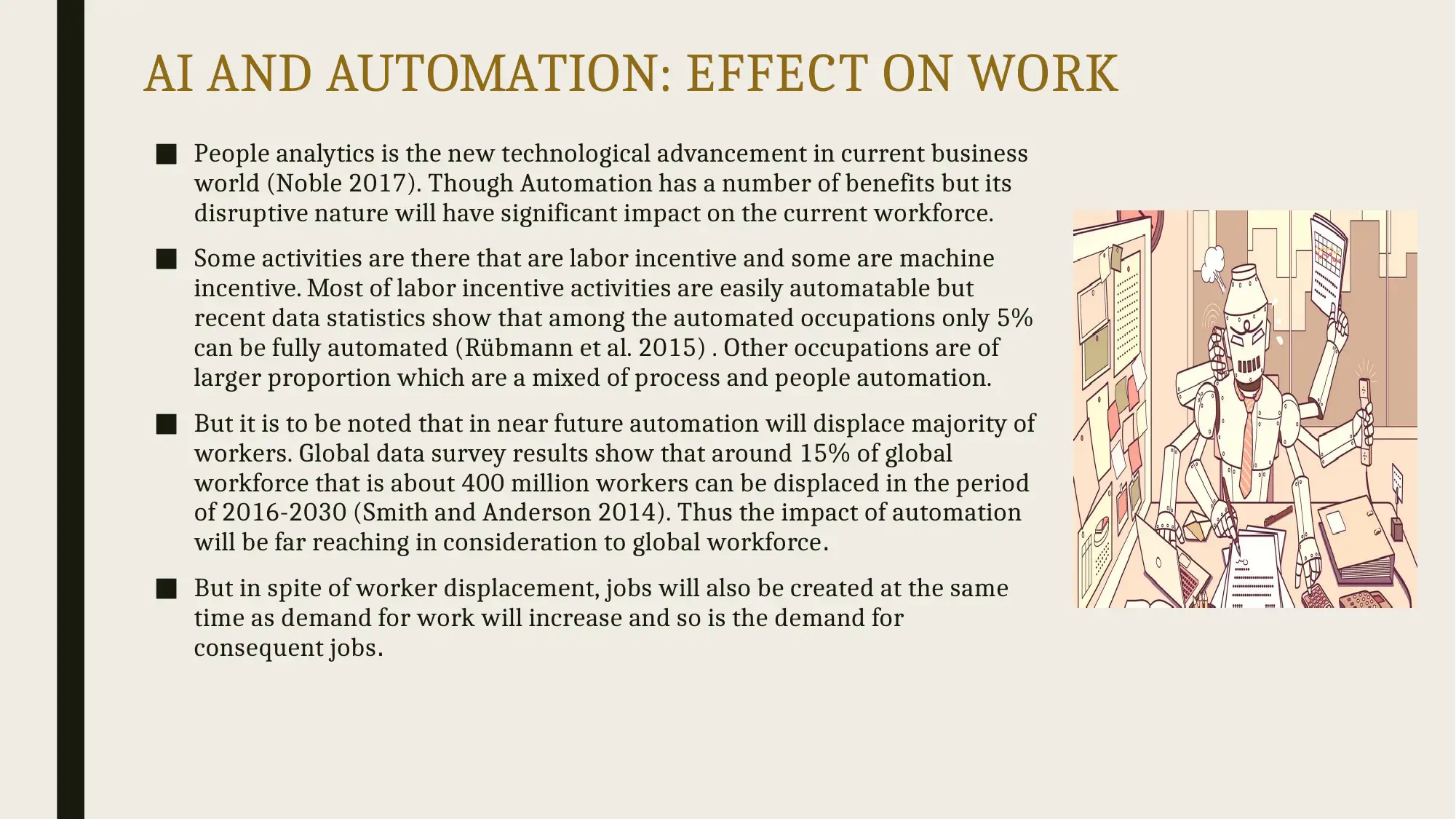
AI AND AUTOMATION: EFFECT ON WORK
■ People analytics is the new technological advancement in current business
world (Noble 2017). Though Automation has a number of benefits but its
disruptive nature will have significant impact on the current workforce.
■ Some activities are there that are labor incentive and some are machine
incentive. Most of labor incentive activities are easily automatable but
recent data statistics show that among the automated occupations only 5%
can be fully automated (Rübmann et al. 2015) . Other occupations are of
larger proportion which are a mixed of process and people automation.
■ But it is to be noted that in near future automation will displace majority of
workers. Global data survey results show that around 15% of global
workforce that is about 400 million workers can be displaced in the period
of 2016-2030 (Smith and Anderson 2014). Thus the impact of automation
will be far reaching in consideration to global workforce.
■ But in spite of worker displacement, jobs will also be created at the same
time as demand for work will increase and so is the demand for
consequent jobs.
■ People analytics is the new technological advancement in current business
world (Noble 2017). Though Automation has a number of benefits but its
disruptive nature will have significant impact on the current workforce.
■ Some activities are there that are labor incentive and some are machine
incentive. Most of labor incentive activities are easily automatable but
recent data statistics show that among the automated occupations only 5%
can be fully automated (Rübmann et al. 2015) . Other occupations are of
larger proportion which are a mixed of process and people automation.
■ But it is to be noted that in near future automation will displace majority of
workers. Global data survey results show that around 15% of global
workforce that is about 400 million workers can be displaced in the period
of 2016-2030 (Smith and Anderson 2014). Thus the impact of automation
will be far reaching in consideration to global workforce.
■ But in spite of worker displacement, jobs will also be created at the same
time as demand for work will increase and so is the demand for
consequent jobs.
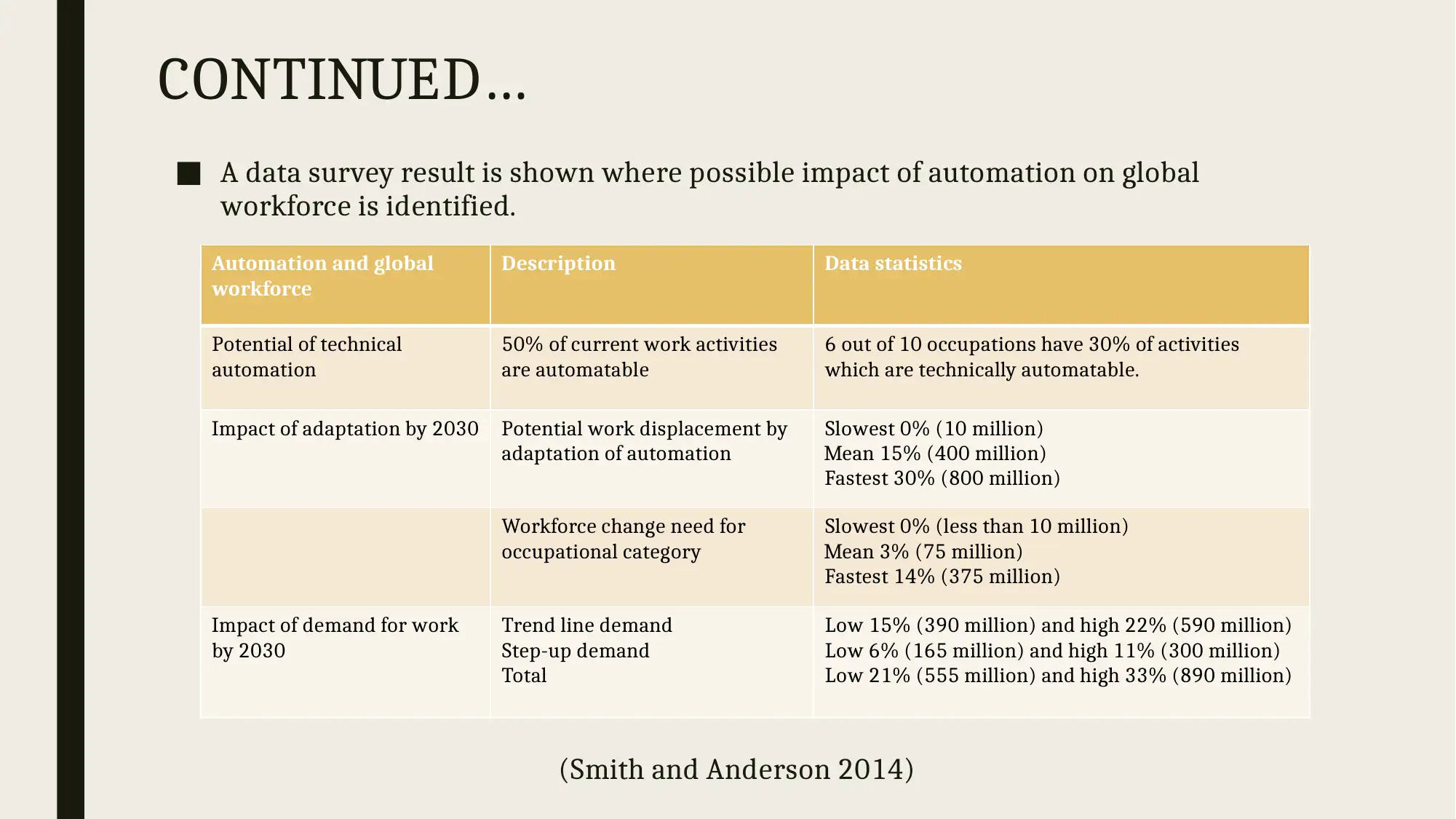
CONTINUED…
■ A data survey result is shown where possible impact of automation on global
workforce is identified.
(Smith and Anderson 2014)
Automation and global
workforce
Description Data statistics
Potential of technical
automation
50% of current work activities
are automatable
6 out of 10 occupations have 30% of activities
which are technically automatable.
Impact of adaptation by 2030 Potential work displacement by
adaptation of automation
Slowest 0% (10 million)
Mean 15% (400 million)
Fastest 30% (800 million)
Workforce change need for
occupational category
Slowest 0% (less than 10 million)
Mean 3% (75 million)
Fastest 14% (375 million)
Impact of demand for work
by 2030
Trend line demand
Step-up demand
Total
Low 15% (390 million) and high 22% (590 million)
Low 6% (165 million) and high 11% (300 million)
Low 21% (555 million) and high 33% (890 million)
■ A data survey result is shown where possible impact of automation on global
workforce is identified.
(Smith and Anderson 2014)
Automation and global
workforce
Description Data statistics
Potential of technical
automation
50% of current work activities
are automatable
6 out of 10 occupations have 30% of activities
which are technically automatable.
Impact of adaptation by 2030 Potential work displacement by
adaptation of automation
Slowest 0% (10 million)
Mean 15% (400 million)
Fastest 30% (800 million)
Workforce change need for
occupational category
Slowest 0% (less than 10 million)
Mean 3% (75 million)
Fastest 14% (375 million)
Impact of demand for work
by 2030
Trend line demand
Step-up demand
Total
Low 15% (390 million) and high 22% (590 million)
Low 6% (165 million) and high 11% (300 million)
Low 21% (555 million) and high 33% (890 million)
⊘ This is a preview!⊘
Do you want full access?
Subscribe today to unlock all pages.

Trusted by 1+ million students worldwide
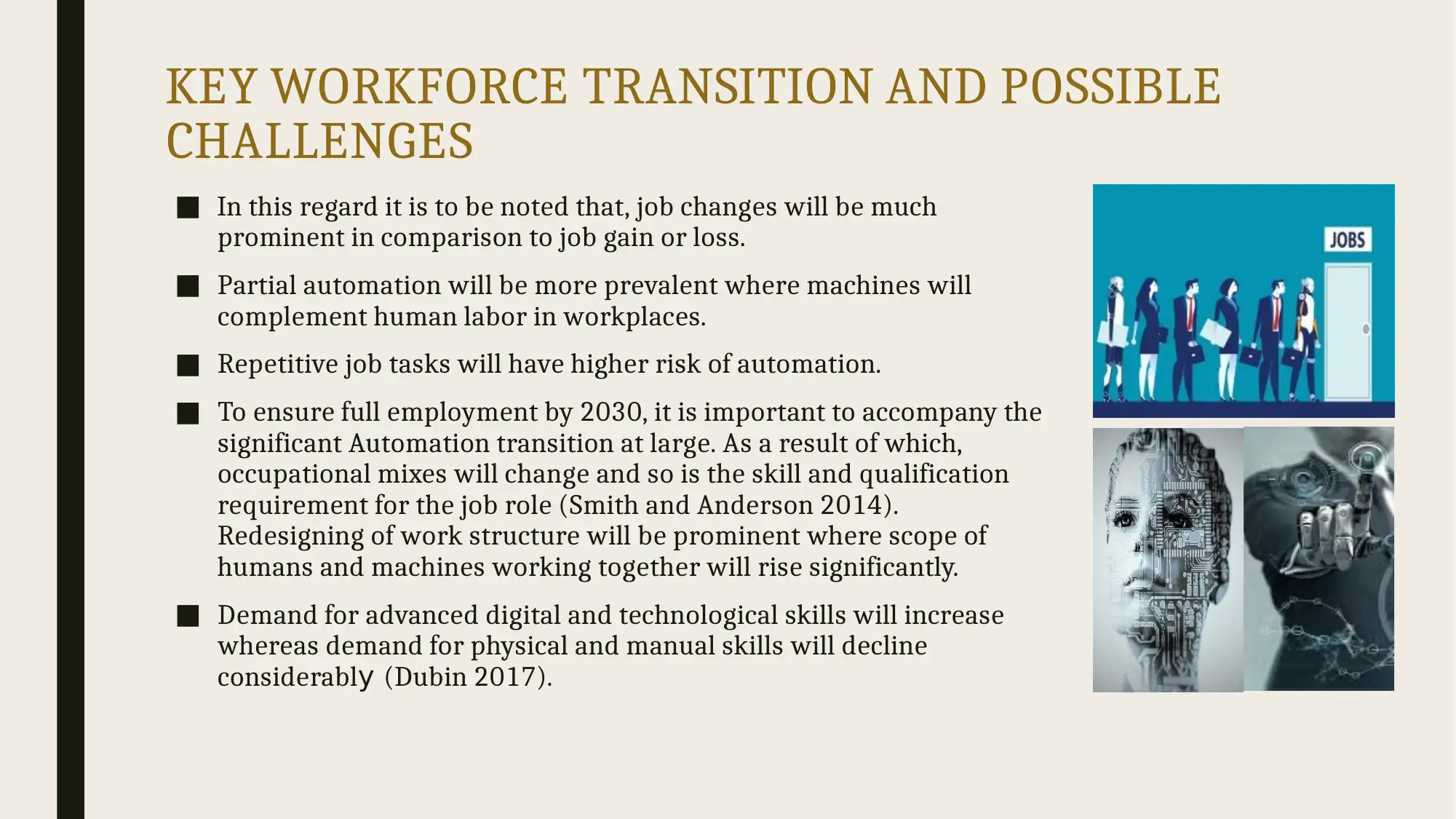
KEY WORKFORCE TRANSITION AND POSSIBLE
CHALLENGES
■ In this regard it is to be noted that, job changes will be much
prominent in comparison to job gain or loss.
■ Partial automation will be more prevalent where machines will
complement human labor in workplaces.
■ Repetitive job tasks will have higher risk of automation.
■ To ensure full employment by 2030, it is important to accompany the
significant Automation transition at large. As a result of which,
occupational mixes will change and so is the skill and qualification
requirement for the job role (Smith and Anderson 2014).
Redesigning of work structure will be prominent where scope of
humans and machines working together will rise significantly.
■ Demand for advanced digital and technological skills will increase
whereas demand for physical and manual skills will decline
considerably (Dubin 2017).
CHALLENGES
■ In this regard it is to be noted that, job changes will be much
prominent in comparison to job gain or loss.
■ Partial automation will be more prevalent where machines will
complement human labor in workplaces.
■ Repetitive job tasks will have higher risk of automation.
■ To ensure full employment by 2030, it is important to accompany the
significant Automation transition at large. As a result of which,
occupational mixes will change and so is the skill and qualification
requirement for the job role (Smith and Anderson 2014).
Redesigning of work structure will be prominent where scope of
humans and machines working together will rise significantly.
■ Demand for advanced digital and technological skills will increase
whereas demand for physical and manual skills will decline
considerably (Dubin 2017).
Paraphrase This Document
Need a fresh take? Get an instant paraphrase of this document with our AI Paraphraser
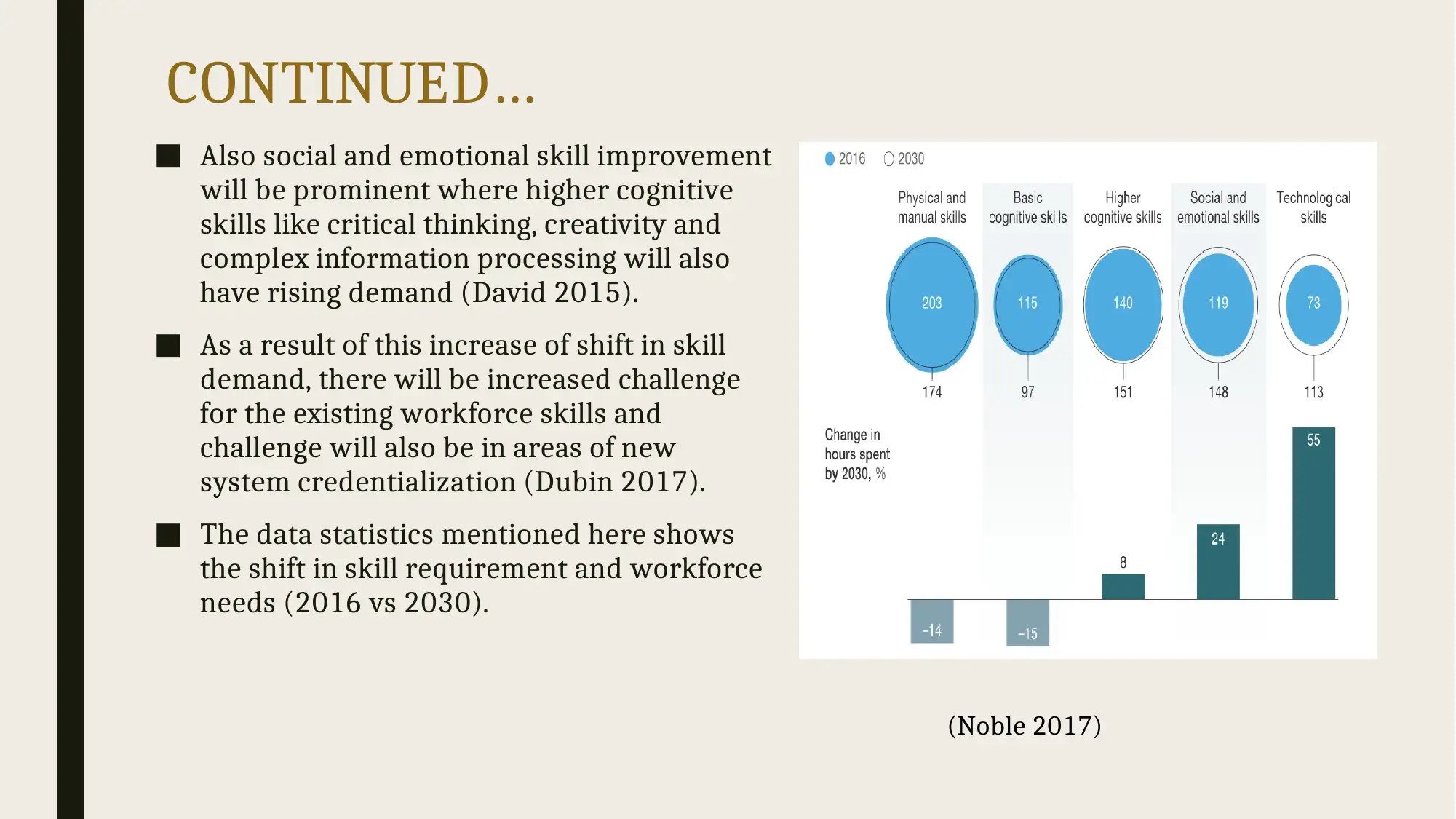
CONTINUED…
■ Also social and emotional skill improvement
will be prominent where higher cognitive
skills like critical thinking, creativity and
complex information processing will also
have rising demand (David 2015).
■ As a result of this increase of shift in skill
demand, there will be increased challenge
for the existing workforce skills and
challenge will also be in areas of new
system credentialization (Dubin 2017).
■ The data statistics mentioned here shows
the shift in skill requirement and workforce
needs (2016 vs 2030).
(Noble 2017)
■ Also social and emotional skill improvement
will be prominent where higher cognitive
skills like critical thinking, creativity and
complex information processing will also
have rising demand (David 2015).
■ As a result of this increase of shift in skill
demand, there will be increased challenge
for the existing workforce skills and
challenge will also be in areas of new
system credentialization (Dubin 2017).
■ The data statistics mentioned here shows
the shift in skill requirement and workforce
needs (2016 vs 2030).
(Noble 2017)
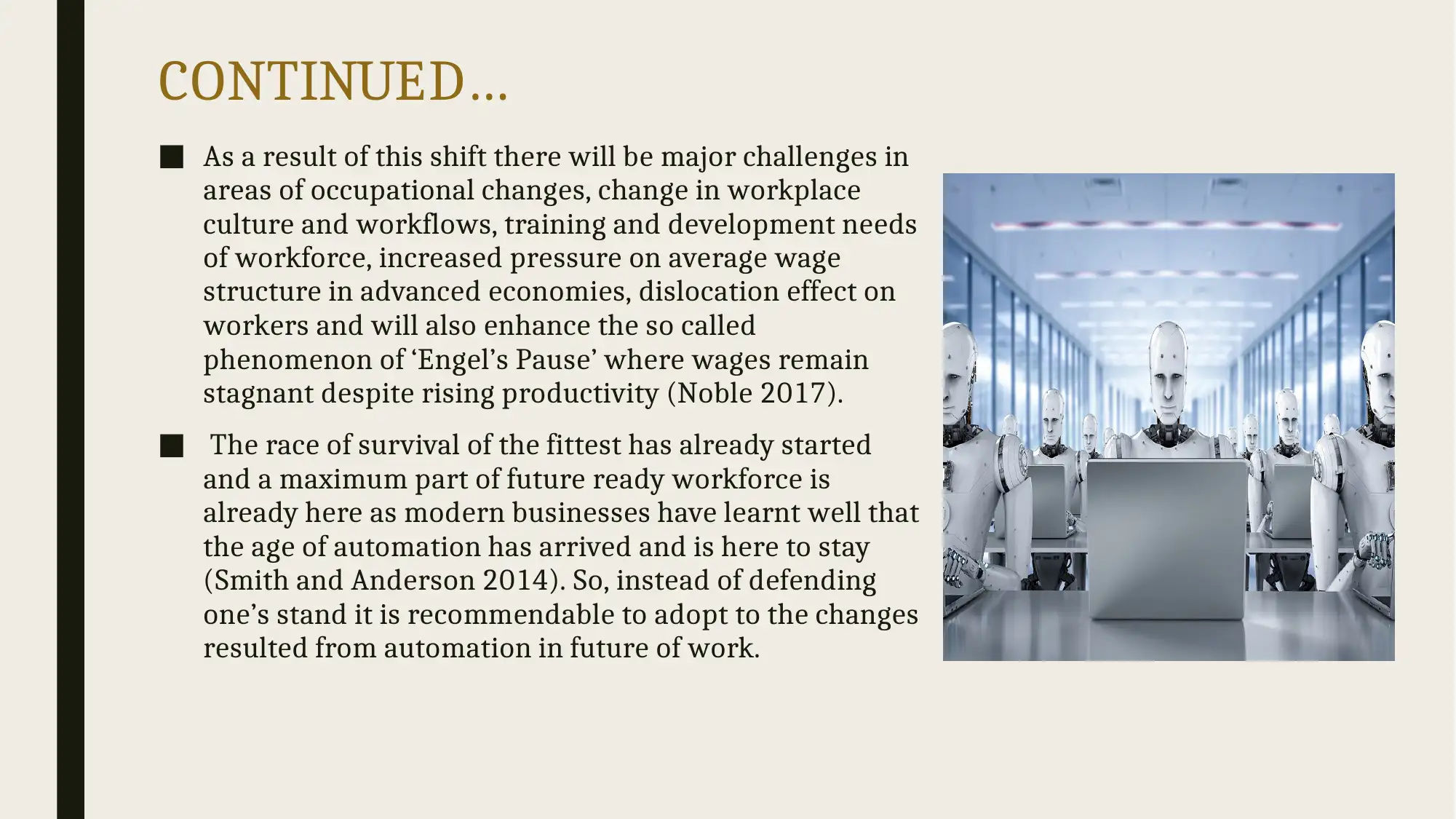
CONTINUED…
■ As a result of this shift there will be major challenges in
areas of occupational changes, change in workplace
culture and workflows, training and development needs
of workforce, increased pressure on average wage
structure in advanced economies, dislocation effect on
workers and will also enhance the so called
phenomenon of ‘Engel’s Pause’ where wages remain
stagnant despite rising productivity (Noble 2017).
■ The race of survival of the fittest has already started
and a maximum part of future ready workforce is
already here as modern businesses have learnt well that
the age of automation has arrived and is here to stay
(Smith and Anderson 2014). So, instead of defending
one’s stand it is recommendable to adopt to the changes
resulted from automation in future of work.
■ As a result of this shift there will be major challenges in
areas of occupational changes, change in workplace
culture and workflows, training and development needs
of workforce, increased pressure on average wage
structure in advanced economies, dislocation effect on
workers and will also enhance the so called
phenomenon of ‘Engel’s Pause’ where wages remain
stagnant despite rising productivity (Noble 2017).
■ The race of survival of the fittest has already started
and a maximum part of future ready workforce is
already here as modern businesses have learnt well that
the age of automation has arrived and is here to stay
(Smith and Anderson 2014). So, instead of defending
one’s stand it is recommendable to adopt to the changes
resulted from automation in future of work.
⊘ This is a preview!⊘
Do you want full access?
Subscribe today to unlock all pages.

Trusted by 1+ million students worldwide
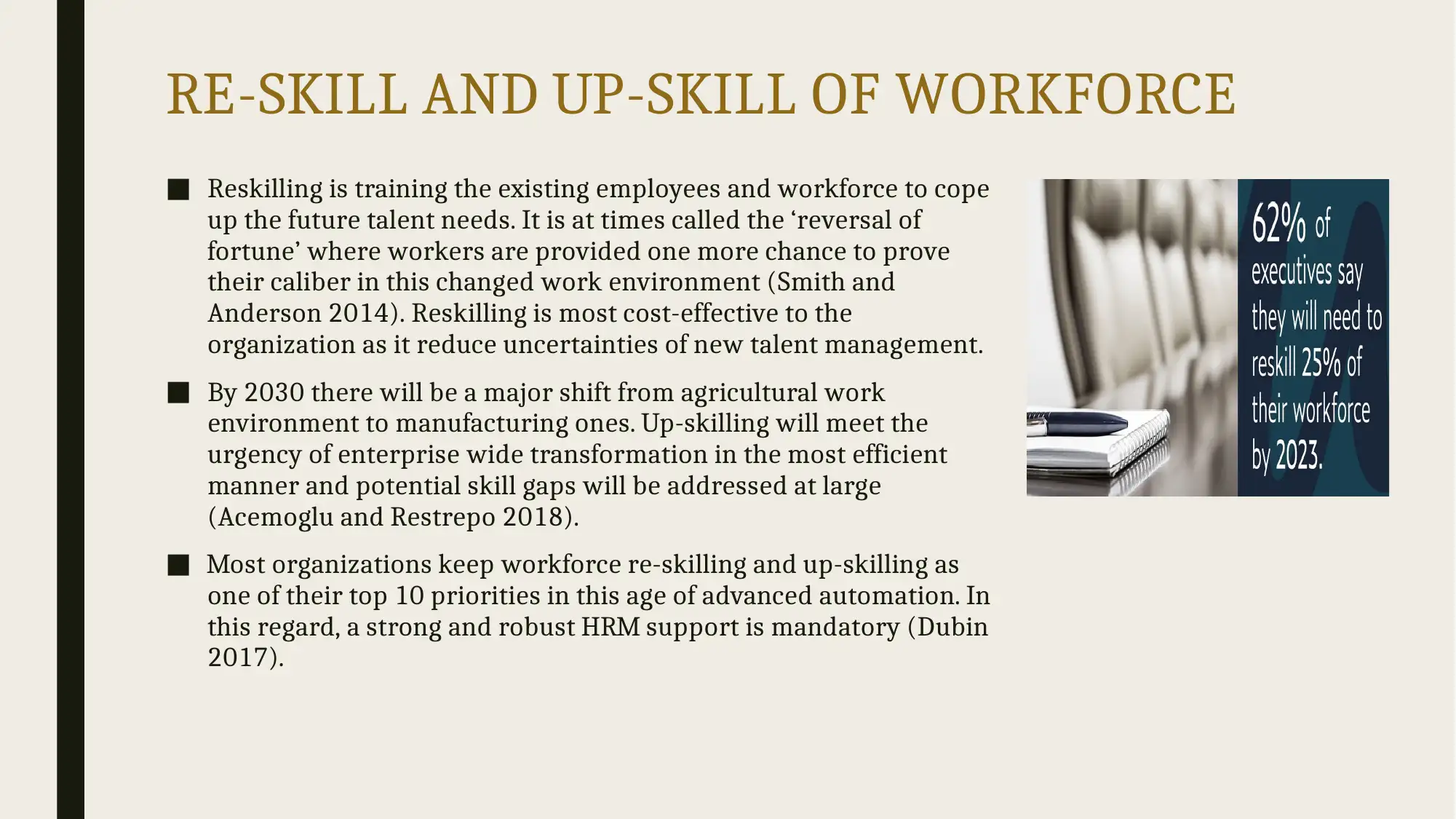
RE-SKILL AND UP-SKILL OF WORKFORCE
■ Reskilling is training the existing employees and workforce to cope
up the future talent needs. It is at times called the ‘reversal of
fortune’ where workers are provided one more chance to prove
their caliber in this changed work environment (Smith and
Anderson 2014). Reskilling is most cost-effective to the
organization as it reduce uncertainties of new talent management.
■ By 2030 there will be a major shift from agricultural work
environment to manufacturing ones. Up-skilling will meet the
urgency of enterprise wide transformation in the most efficient
manner and potential skill gaps will be addressed at large
(Acemoglu and Restrepo 2018).
■ Most organizations keep workforce re-skilling and up-skilling as
one of their top 10 priorities in this age of advanced automation. In
this regard, a strong and robust HRM support is mandatory (Dubin
2017).
■ Reskilling is training the existing employees and workforce to cope
up the future talent needs. It is at times called the ‘reversal of
fortune’ where workers are provided one more chance to prove
their caliber in this changed work environment (Smith and
Anderson 2014). Reskilling is most cost-effective to the
organization as it reduce uncertainties of new talent management.
■ By 2030 there will be a major shift from agricultural work
environment to manufacturing ones. Up-skilling will meet the
urgency of enterprise wide transformation in the most efficient
manner and potential skill gaps will be addressed at large
(Acemoglu and Restrepo 2018).
■ Most organizations keep workforce re-skilling and up-skilling as
one of their top 10 priorities in this age of advanced automation. In
this regard, a strong and robust HRM support is mandatory (Dubin
2017).
Paraphrase This Document
Need a fresh take? Get an instant paraphrase of this document with our AI Paraphraser
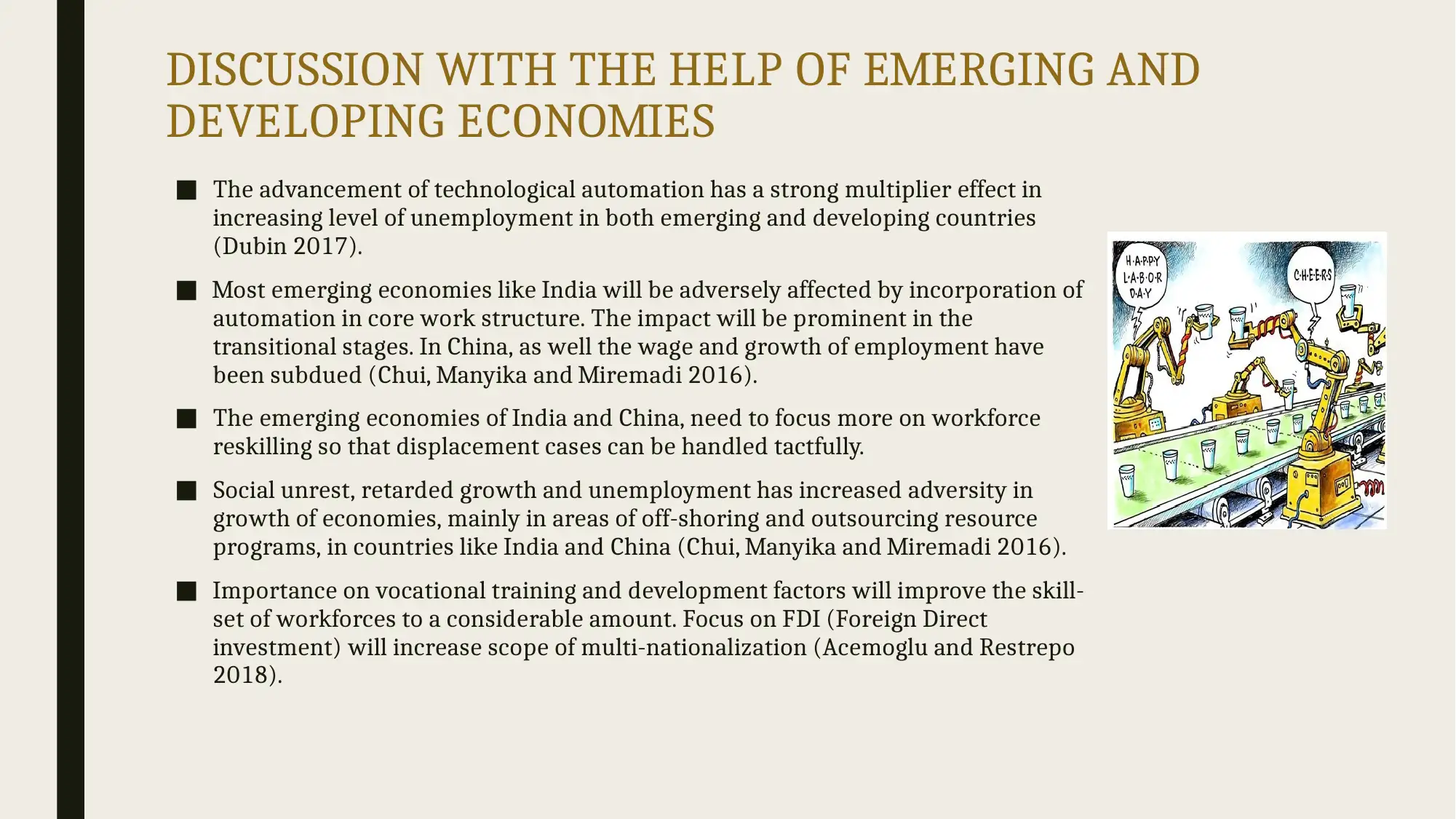
DISCUSSION WITH THE HELP OF EMERGING AND
DEVELOPING ECONOMIES
■ The advancement of technological automation has a strong multiplier effect in
increasing level of unemployment in both emerging and developing countries
(Dubin 2017).
■ Most emerging economies like India will be adversely affected by incorporation of
automation in core work structure. The impact will be prominent in the
transitional stages. In China, as well the wage and growth of employment have
been subdued (Chui, Manyika and Miremadi 2016).
■ The emerging economies of India and China, need to focus more on workforce
reskilling so that displacement cases can be handled tactfully.
■ Social unrest, retarded growth and unemployment has increased adversity in
growth of economies, mainly in areas of off-shoring and outsourcing resource
programs, in countries like India and China (Chui, Manyika and Miremadi 2016).
■ Importance on vocational training and development factors will improve the skill-
set of workforces to a considerable amount. Focus on FDI (Foreign Direct
investment) will increase scope of multi-nationalization (Acemoglu and Restrepo
2018).
DEVELOPING ECONOMIES
■ The advancement of technological automation has a strong multiplier effect in
increasing level of unemployment in both emerging and developing countries
(Dubin 2017).
■ Most emerging economies like India will be adversely affected by incorporation of
automation in core work structure. The impact will be prominent in the
transitional stages. In China, as well the wage and growth of employment have
been subdued (Chui, Manyika and Miremadi 2016).
■ The emerging economies of India and China, need to focus more on workforce
reskilling so that displacement cases can be handled tactfully.
■ Social unrest, retarded growth and unemployment has increased adversity in
growth of economies, mainly in areas of off-shoring and outsourcing resource
programs, in countries like India and China (Chui, Manyika and Miremadi 2016).
■ Importance on vocational training and development factors will improve the skill-
set of workforces to a considerable amount. Focus on FDI (Foreign Direct
investment) will increase scope of multi-nationalization (Acemoglu and Restrepo
2018).
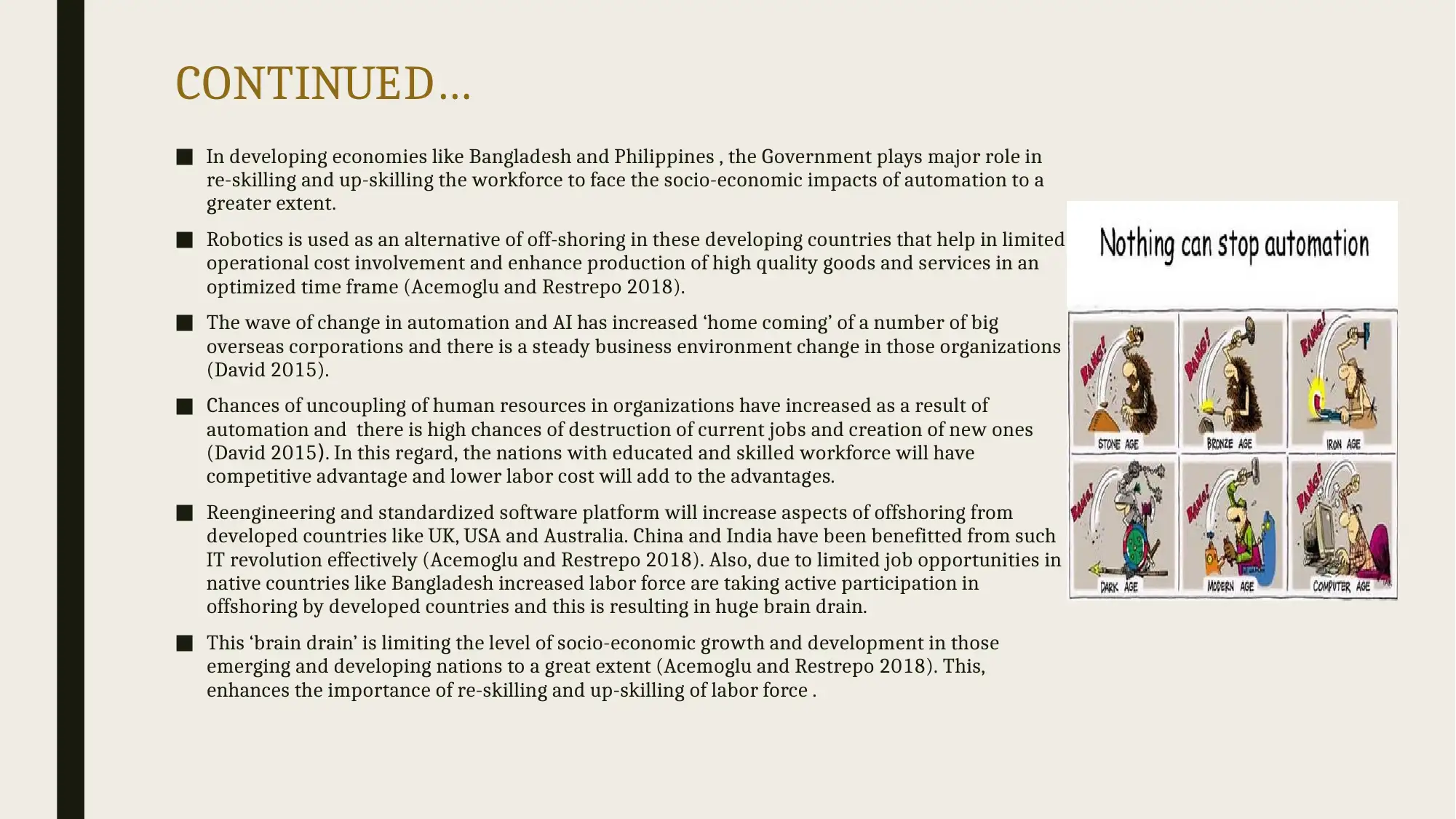
CONTINUED…
■ In developing economies like Bangladesh and Philippines , the Government plays major role in
re-skilling and up-skilling the workforce to face the socio-economic impacts of automation to a
greater extent.
■ Robotics is used as an alternative of off-shoring in these developing countries that help in limited
operational cost involvement and enhance production of high quality goods and services in an
optimized time frame (Acemoglu and Restrepo 2018).
■ The wave of change in automation and AI has increased ‘home coming’ of a number of big
overseas corporations and there is a steady business environment change in those organizations
(David 2015).
■ Chances of uncoupling of human resources in organizations have increased as a result of
automation and there is high chances of destruction of current jobs and creation of new ones
(David 2015). In this regard, the nations with educated and skilled workforce will have
competitive advantage and lower labor cost will add to the advantages.
■ Reengineering and standardized software platform will increase aspects of offshoring from
developed countries like UK, USA and Australia. China and India have been benefitted from such
IT revolution effectively (Acemoglu and Restrepo 2018). Also, due to limited job opportunities in
native countries like Bangladesh increased labor force are taking active participation in
offshoring by developed countries and this is resulting in huge brain drain.
■ This ‘brain drain’ is limiting the level of socio-economic growth and development in those
emerging and developing nations to a great extent (Acemoglu and Restrepo 2018). This,
enhances the importance of re-skilling and up-skilling of labor force .
■ In developing economies like Bangladesh and Philippines , the Government plays major role in
re-skilling and up-skilling the workforce to face the socio-economic impacts of automation to a
greater extent.
■ Robotics is used as an alternative of off-shoring in these developing countries that help in limited
operational cost involvement and enhance production of high quality goods and services in an
optimized time frame (Acemoglu and Restrepo 2018).
■ The wave of change in automation and AI has increased ‘home coming’ of a number of big
overseas corporations and there is a steady business environment change in those organizations
(David 2015).
■ Chances of uncoupling of human resources in organizations have increased as a result of
automation and there is high chances of destruction of current jobs and creation of new ones
(David 2015). In this regard, the nations with educated and skilled workforce will have
competitive advantage and lower labor cost will add to the advantages.
■ Reengineering and standardized software platform will increase aspects of offshoring from
developed countries like UK, USA and Australia. China and India have been benefitted from such
IT revolution effectively (Acemoglu and Restrepo 2018). Also, due to limited job opportunities in
native countries like Bangladesh increased labor force are taking active participation in
offshoring by developed countries and this is resulting in huge brain drain.
■ This ‘brain drain’ is limiting the level of socio-economic growth and development in those
emerging and developing nations to a great extent (Acemoglu and Restrepo 2018). This,
enhances the importance of re-skilling and up-skilling of labor force .
⊘ This is a preview!⊘
Do you want full access?
Subscribe today to unlock all pages.

Trusted by 1+ million students worldwide
1 out of 16
Related Documents
Your All-in-One AI-Powered Toolkit for Academic Success.
+13062052269
info@desklib.com
Available 24*7 on WhatsApp / Email
![[object Object]](/_next/static/media/star-bottom.7253800d.svg)
Unlock your academic potential
Copyright © 2020–2025 A2Z Services. All Rights Reserved. Developed and managed by ZUCOL.




